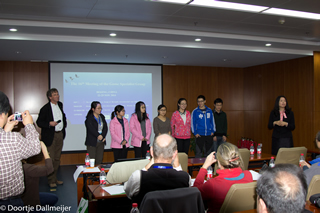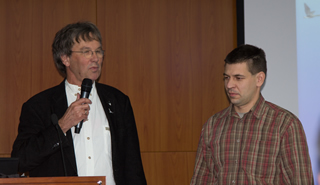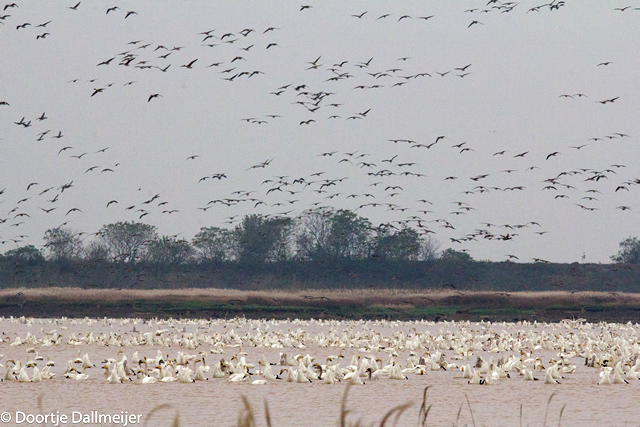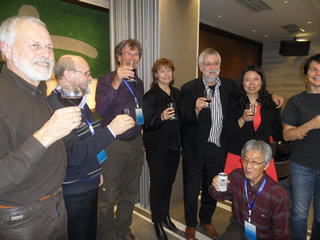|
|
|
The Goose Specialist Group of Wetlands International is a IUCN species specialist group that seeks to strengthen contacts between all researchers on migratory goose populations in the northern hemisphere. A database with goose censuses from the western palearctic is supported by a network of national coordinators. At present 400 people have joined the group.
Report of the 16th meeting of the Goose Specialist Group in Bejing, China from 22th-25th November, 2014

Group picture of participants to the 16th Goose Specialist Group Conference in Beijing (courtesy of Yuzhan Yang)
The 16th meeting of the Goose Specialist Group of Wetlands International and the IUCN-Species Survival Commission (GSG) was held from 22-25 November 2014 in Beijing, China. The meeting attracted 166 delegates from 15 different countries and it was the third meeting of the Goose Specialist Group in Asia (Matsushima, Japan in 1999 and Ladakh, India in 2008).
Apart from the host country China (represented by 77 participants), 49 delegates attended the meeting from 14 other countries, including the Russian Federation (11), Mongolia (3), Japan (5), South Korea (1), India (1), Australia (1), USA (1), England (2), Denmark (1), Norway (2), the Netherlands (6), Belgium (3), Finland (1) and Germany (1) .
The meeting was very well organized on behalf of the GSG by the team of Prof. Cao Lei from
Research Center for Eco-Environmental Sciences of the Chinese Academy of Sciences (RCEES). The meeting was generously supported by the National Natural Science Foundation of China, BirdLife International and the Dutch Faunafund.
Although most goose populations in North America and Europe are thriving, and in the case of some species are even considered to be “too numerous”, in China, goose populations have seriously declined, which is therefore a matter of concern.
Next to the meeting room an impressive photo exhibition on the theme of “waterbirds and wetlands” illustrated the wealth of waterbird species in East Asia.
|
|
|
Chairman Barwolt Ebbinge (left) and Prof. Cao Lei (right) thank her staff members for all their work during the conference (courtesy of Doortje Dallmeijer) |
During the three days of the conference, delegates listened to 43 oral presentations in English, 1 in Mongolian and 1 in Chinese, together with 7 poster presentations. These presentations illustrated our current knowledge of goose populations in East Asia as well as highlighting our knowledge gaps, and how to fill these gaps with new research and new research techniques, including logging devices combined with triaxial accelerometers that both track the geese in space and time and simultaneously record their behaviour throughout the annual cycle.
Sharing technical knowledge on goose tagging studies.
To make an inventory of the technical problems that can occur with the increased and fascinating use of transmitters and loggers, Thomas Lameris and Petr Glazov initiated a special working group
to better share the current knowledge on tagging of geese, and to create a platform for good tagging practice.
They plan to:
- collect contact information of all people working on goose tagging studies, as to create a list for the use of alle members of the GSG;
- Compile information on tagging techniques;
- Organise a tagging workshop on the GSG meeting in Salekhard, Russia (2015);
- Write a review on important consideration when tagging geese / birds.
Everyone that is or has been working on tagging geese, is kindly asked to provide Thomas Lameris (thomaslameris@gmail.com) with their contact information (name, e-mail address and institute) and both the species you have been working on and the attachment method (backpack, collar or legband) and type of tags (e.g. geolocator, satellite tag, GPS-logger including brand name) you have been using.
Further subjects covered in the programme included the degree to which migratory geese are involved in spreading avian influenza, impacts of climate change on the breeding success of Swan Geese, poaching with nets and poison, the role of ecotourism and the status of various East Asian goose populations (notably Swan Geese, Bar-headed Geese, Bean Geese, White-fronted Geese and Lesser White-fronted Geese) were discussed at length.
It was also encouraging to note the results of good co-operation between Chinese universities and the universities in Aarhus (DK) and Wageningen (NL) studying goose behaviour on Chinese wintering grounds.
Judit Szabo from the East Asian-Australasian Flyway Partnership, Liying Su from the International Crane Foundation, Nina Mikander from the African Eurasian migratory Waterbird Agreement (AEWA) and Peter Prokosch with his new project “Linking tourism and conservation” (www.ltandc.org ) all contributed their experiences of working in partnerships and their ideas for the future to fruitful group discussions.
Co-chair appointed.
|
|
|
Chairman Barwolt Ebbinge and newly appointed co-chair Petr Glazov (courtesy of Doortje Dallmeijer) |
To relieve some of the workload of the current chairman, Petr Glazov from Moscow was appointed as co-chair of the GSG. Petr is a very active goose researcher, and also a regular attendant of the GSG-meetings. As a token of appreciation for his work chairing the GSG over the last 18 years chairman Barwolt Ebbinge received a copy of Jan van de Kam’s beautiful book “Invisible Connections” from the representative of Wetlands International in China.
Next meeting
Yevgeniy Syroechkovskiy and Sofia Rozenfeld invited the GSG to hold the 17th meeting in November/December 2015 in Salekhard, Russia jointly with the Russian Goose, Swan and Duck Study Group of Northern Eurasia. This invitation was unanimously accepted and more details will soon be given on this website.
Field trip to Poyang Lake
|
|
|
Tundra swans feeding on Vallisneria in Poyang Lake and Eastern Tundra Bean Geese in the air (courtesy of Doortje Dallmeijer) |
|
|
|
GSG-members Johan Mooij, Aleksandr Kondratyev, Barwolt Ebbinge, Ingunn Tombre, Tony Fox, Cao Lei, Masayuki Kurechi and Judit Szabo celebrate the end of the conference (courtesy of Doortje Dallmeijer) |
After the conference a field trip to the largest freshwater lake in China, Poyang Lake, was organized. Here the participants witnessed no less than 4 different species of cranes (Siberian Crane, White-naped Crane, Hooded Crane and Eurasian Crane), hundreds of Greater White-fronted Geese, several thousands of Eastern Tundra Bean Geese (Anser fabalis serrirostris), hundreds of just arrived Swan Geese, thousands of Oriental Storks, hundreds of Eurasian Spoonbills, over 10,000 Tundra swans feeding on Vallisneria, 800 roosting Night Herons, tens of thousands of Little Grebes and similar numbers of Spotted Redshank, by far the most common wader species around this impressive lake, though also hundreds of Lapwings were observed.
It was impressive to see how in a fast developing country like China with an excellent infrastructure of roads and airports, still many arctic-nesting wild birds can spend the winter undisturbed on this protected wetland.
Authors that would like to submit their presented papers for publication are asked to contact the Editor-in-Chief Guangmei Zheng of the peer-reviewed journal Avian Research (editorial@avianres.com) or the Editor-in-Chief Johan Mooij of the electronic Goose Bulletin of the GSG (johan.mooij@bskw.de)
Barwolt S. Ebbinge (chair GSG) and Petr M. Glazov (co-chair GSG)
The present global coordinator is Bart Ebbinge, based at the Alterra, Green World Research Institute in Wageningen, the Netherlands. Regional coordinators are Ray Alisauskas based at the Canadian Wildlife Service in Saskatoon, Saskatchewan (Canada) for North America and Masayuki Kurechi of the Japanese Association for Wild Geese Protection in Wakayanagi (Japan) for East Asia.
Membership
At present about 600 people are on the mailing list of the Goose Specialist Group. Ingunn Tombre has accepted the task to bring our membership list up-to-date. Our membership is for free and open to anyone, and if you would like to join, please register with Ingunn Tombre.
Meetings
Annual meetings are held since 1995. The next and 16th meeting will be held in Hefei, Anhui, China and has been postponed to November 2014. The exact dates will be announced a.s.a.p. This meeting will be organized by Prof. Cao Lei from the University of Science and Technology of China (USTC) in Hefei, and will include field trips to Shengjin Lake and Poyang Lake. More information about this meeting can be found in the most recent 16th issue of our Goose Bulletin.
The15th meeting of the Goose Specialist Group was held in the Palace of Congress of Arcachon, France, from 8-11 January 2013. Go to all meetings
Obituary Prakash Gole
 In December we heard of the sad news that Prakash Gole, the Bar-headed Goose coordinator who organized the GSG-meeting in Ladakh in 2008, passed away on 27 November 2013. For more information please visit his obituary.
In December we heard of the sad news that Prakash Gole, the Bar-headed Goose coordinator who organized the GSG-meeting in Ladakh in 2008, passed away on 27 November 2013. For more information please visit his obituary.
The proceedings of the 15th meeting of the Goose SG are available
The proceedings of the 15th meeting of the Goose Specialist Group in France in January 2013 have appeared as a special edition of the journal Wildfowl
By sending an email to wildfowl@wwt.org.uk a copy of this Special Issue (nr.3) can be ordered at the cost of £17 plus an additional £3.50 for credit card transactions.
Proceedings of the 14th meeting of the Goose Specialist Group of the IUCN Species Survival Commission and Wetlands International are now available online!
During the 14th meeting of the Goose Specialist Group which was held in Steinkjer, Norway in April 2012, contributors were invited to submit articles to the online journal Ornis Norvegica. Ornis Norvegica is the scientific journal of the Norwegian Ornithological Society (Norsk Ornitologisk Forening – NOF). I am pleased to announce that the proceedings have finally been published. You can find articles from the 2012 meeting, as well as a number of other ornithological papers which are surely of interest on the journal website: https://boap.uib.no/index.php/ornis/index/
Paul Shimmings
November 2013 Goose Bulletin
The latest Goose Bulletin (nr 17) appeared in November 2013 and can be downloaded from the goose bulletin pages. Submissions for the next Goose Bulletin, scheduled to appear in the 2nd quarter of 2014 should be sent to Johan Mooij (johan.mooij@bskw.de) before the 31st of March 2014.
The Goose Specialist Group of Wetlands International and the IUCN Species Survival Committee seeks to strengthen contacts between all researchers on migratory goose populations in the northern hemisphere. A database with goose censuses from the western palearctic is supported by a network of national coordinators. Annual meetings are held since 1995. At present 400 people have joined the group.
The present global coordinator is Bart Ebbinge, based at the Alterra, Green World Research Institute in Wageningen, the Netherlands. Regional coordinators are Ray Alisauskas based at the Canadian Wildlife Service in Saskatoon, Saskatchewan (Canada) for North America and Masayuki Kurechi of the Japanese Association for Wild Geese Protection in Wakayanagi (Japan) for East Asia.
Membership
At present about 600 people are on the mailing list of the Goose Specialist Group. Ingunn Tombre has accepted the task to bring our membership list up-to-date. Our membership is for free and open to anyone, and if you would like to join, please register with Ingunn Tombre.









